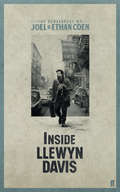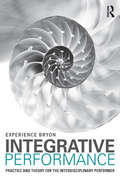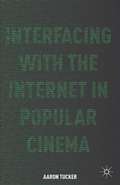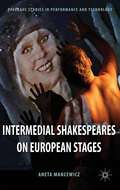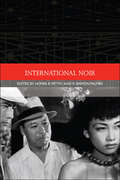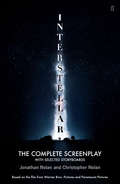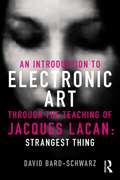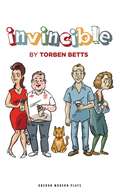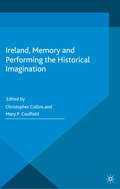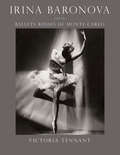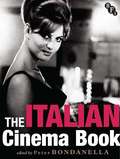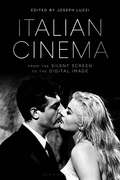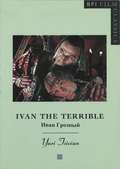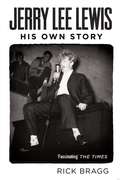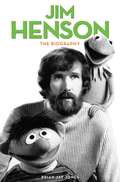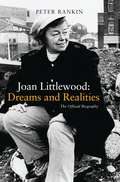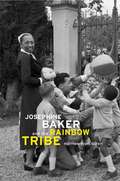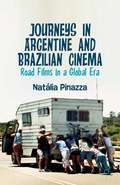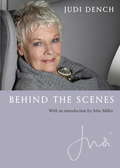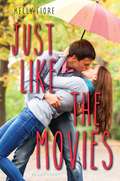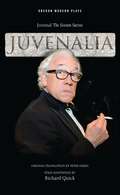- Table View
- List View
Inside Llewyn Davis: The Screenplay
by Joel Coen And Ethan CoenInside Llewyn Davis chronicles a struggling young folk singer, played by Oscar Isaacs, who arrives in Manhattan in 1961 and tries to navigate the treacherous waters of the the Greenwich Village coffeehouse scene, as well as having to deal with a disaffected girlfriend, his father's dementia, the suicide of his musical partner, and the loss of his friend's cat...Suffused with the music of the time, the film is an emotional journey inside the soul of Llewyn Davis.
Integrative Performance: Practice and Theory for the Interdisciplinary Performer
by Experience BryonIntegrative Performance serves a crucial need of 21st-century performers by providing a transdisciplinary approach to training. Its radical new take on performance practice is designed for a climate that increasingly requires fully rounded artists. The book critiques and interrogates key current practices and offers a proven alternative to the idea that rigorous and effective training must separate the disciplines into discrete categories of acting, singing, and dance. Experience Bryon’s Integrative Performance Practice is a way of working that will profoundly shift how performers engage with their training, conditioning and performance disciplines. It synthesizes the various elements of performance work in order to empower the performer as they practice across disciplines within any genre, style or aesthetic. Theory and practice are balanced throughout, using: Regular box-outs, introducing the work's theoretical underpinnings through quotes, case studies and critical interjections. A full program of exercises ranging from training of specific muscle groups, through working with text, to more subtle structures for integrative awareness and presence. This book is the result of over twenty years of practice and research working with interdisciplinary artists across the world to produce a training that fully prepares performers for the demands of contemporary performance and all its somatic, emotive and vocal possibilities.
Integrative Performance: Practice and Theory for the Interdisciplinary Performer
by Experience BryonIntegrative Performance serves a crucial need of 21st-century performers by providing a transdisciplinary approach to training. Its radical new take on performance practice is designed for a climate that increasingly requires fully rounded artists. The book critiques and interrogates key current practices and offers a proven alternative to the idea that rigorous and effective training must separate the disciplines into discrete categories of acting, singing, and dance. Experience Bryon’s Integrative Performance Practice is a way of working that will profoundly shift how performers engage with their training, conditioning and performance disciplines. It synthesizes the various elements of performance work in order to empower the performer as they practice across disciplines within any genre, style or aesthetic. Theory and practice are balanced throughout, using: Regular box-outs, introducing the work's theoretical underpinnings through quotes, case studies and critical interjections. A full program of exercises ranging from training of specific muscle groups, through working with text, to more subtle structures for integrative awareness and presence. This book is the result of over twenty years of practice and research working with interdisciplinary artists across the world to produce a training that fully prepares performers for the demands of contemporary performance and all its somatic, emotive and vocal possibilities.
Interfacing with the Internet in Popular Cinema
by A. TuckerThe Internet is the most terrifying and most beautifully innovative invention of the twentieth century. Using film theory and close textual analysis, Tucker offers an explanation of the Internet and a brief history of its portrayal on film in order examine how it has shaped contemporary versions of self-identity, memory, and the human body.
Intermedial Shakespeares on European Stages (Palgrave Studies in Performance and Technology)
by A. MancewiczIntermedial Shakespeares argues that intermediality has refashioned performances of Shakespeare's plays over the last two decades in Europe. It describes ways in which text and author, time and space, actor and audience have been redefined in Shakespearean productions that incorporate digital media, and it traces transformations in practice.
International Noir (Traditions in World Cinema)
by Homer B. Pettey R. Barton PalmerFollowing World War II, film noir became the dominant cinematic expression of Cold War angst, influencing new trends in European and Asian filmmaking. International Noir examines film noir’s influence on the cinematic traditions of Britain, France, Scandinavia, Japan, Hong Kong, Korea, and India. This book suggests that the film noir style continues to appeal on such a global scale because no other cinematic form has merged style and genre to effect a vision of the disturbing consequences of modernity. International noir has, however, adapted and adopted noir themes and aesthetic elements so that national cinemas can boast an independent and indigenous expression of the genre. Ranging from Japanese silent films and women’s films to French, Hong Kong, and Nordic New Waves, this book also calls into question critical assessments of noir in international cinemas. In short, it challenges prevailing film scholarship to renegotiate the concept of noir. Ending with an examination of Hollywood’s neo-noir recontextualization of the genre, and post-noir’s reinvigorating critique of this aesthetic, International Noir offers Film Studies scholars an in-depth commentary on this influential global cinematic art form, further offering extensive bibliography and filmographies for recommended reading and viewing.
Interstellar: The Complete Screenplay With Selected Storyboards
by Christopher Nolan Jonathan NolanIn Interstellar a group of explorers make use of a newly discovered wormhole to surpass the limitations on human space travel and conquer the vast distances involved in an interstellar voyage. The screenplay of Interstellar is written by Christopher Nolan and his frequent collaborator, Jonathan Nolan. In addition to the screenplay, this screenplay book also contains over 200 pages of storyboards and an Introduction featuring a conversation about the film with Christopher Nolan and Jonathan Nolan. The screenplay book is based on the film from Warner Bros. Pictures and Paramount Pictures. Interstellar and all related characters and elements are trademarks of and © Warner Bros. Entertainment Inc. (s14).
An Introduction to Electronic Art Through the Teaching of Jacques Lacan: Strangest Thing
by David Bard-SchwarzElectronic art offers endless opportunities for reflection and interpretation. Works can be interactive or entirely autonomous and the viewer's perception and reaction to them may be challenged by constantly transforming images. Whether the transformations are a product of the appearances or actions of a viewer in an installation space, or a product of a self-contained computer program, is a source of constant fascination. Some viewers may feel strange or unnerved by a work, while others may feel welcoming, humorous, and playful emotions. The art may also provoke a critical response to social, aesthetic, and political aspects of early twenty-first-century life. This book approaches electronic art through the teachings of Jacques Lacan, whose return to Freud has exerted a powerful and wide-ranging influence on psychoanalysis and critical theory in the twentieth century. David Bard-Schwarz draws on his experience with Lacanian psychoanalysis, music, and interactive and traditional arts in order to address aspects of the works the viewer may find difficult to understand. Dividing his approach over four thematic chapters—Bodies, Voices, Eyes, and Signifiers—Bard-Schwarz explores the links between works of new media and psychoanalysis (how we process what we see, hear, touch, imagine, and remember). This is a fascinating book for new media artists and critics, museum curators, psychologists, students in the fine arts, and those who are interested in digital technology and contemporary culture.
An Introduction to Electronic Art Through the Teaching of Jacques Lacan: Strangest Thing
by David Bard-SchwarzElectronic art offers endless opportunities for reflection and interpretation. Works can be interactive or entirely autonomous and the viewer's perception and reaction to them may be challenged by constantly transforming images. Whether the transformations are a product of the appearances or actions of a viewer in an installation space, or a product of a self-contained computer program, is a source of constant fascination. Some viewers may feel strange or unnerved by a work, while others may feel welcoming, humorous, and playful emotions. The art may also provoke a critical response to social, aesthetic, and political aspects of early twenty-first-century life. This book approaches electronic art through the teachings of Jacques Lacan, whose return to Freud has exerted a powerful and wide-ranging influence on psychoanalysis and critical theory in the twentieth century. David Bard-Schwarz draws on his experience with Lacanian psychoanalysis, music, and interactive and traditional arts in order to address aspects of the works the viewer may find difficult to understand. Dividing his approach over four thematic chapters—Bodies, Voices, Eyes, and Signifiers—Bard-Schwarz explores the links between works of new media and psychoanalysis (how we process what we see, hear, touch, imagine, and remember). This is a fascinating book for new media artists and critics, museum curators, psychologists, students in the fine arts, and those who are interested in digital technology and contemporary culture.
Invincible (Oberon Modern Plays Ser.)
by Torben BettsThe recession is biting hard so Emily and Oliver have decided to downsize and shift their middle-class London lifestyle to a small town in the north of England. They want to live, work and raise their two young children in a friendly community, among what Emily terms ‘real people’, away from the cold anonymity of the city. These left-leaning, well-educated people have invited over two of their new neighbours in an attempt to break the ice. Tonight Alan and Dawn will be offered olives and anchovies and are introduced to Karl Marx and abstract art. As classes and outlooks collide, the scene is set for a rendezvous with consequences as hilarious as they are tragic.
Ireland, Memory and Performing the Historical Imagination
by Mary P. CaulfieldThis book explores the performance of Irish collective memories and forgotten histories. It proposes an alternative and more comprehensive criterion of Irish theatre practices. These practices can be defined as the 'rejected', contested and undervalued plays and performativities that are integral to Ireland's political and cultural landscapes.
Irina Baronova and the Ballets Russes de Monte Carlo
by Victoria TennantIn the 1930s and ’40s, the Ballets Russes de Monte Carlo toured the United States and the world, introducing many to ballet as an art form, while spreading the enduring image of the ballerina as an embodiment of feminine grace and sophistication. This sumptuous, illustrated history tells the story of the rise of modern ballet and its popularity through the life story of one of ballet’s most glamorous stars, Irina Baronova (1919–2008), prima ballerina for the Ballets Russes de Monte Carlo and later for Ballet Theatre in New York. Drawing on letters, correspondence, oral histories, and interviews, Baronova’s daughter, the actress Victoria Tennant, warmly recounts Baronova’s dramatic life, from her earliest aspirations to her grueling time on tour to her later years in Australia as a pioneer of the art. She begins with the Baronov family’s flight from Russia during the Revolution, which led them to Romania and later Paris, where at the age of thirteen, Baronova became a star, chosen by the legendary George Balanchine to join the Ballets Russes, where she danced the lead in Swan Lake. Tennant provides an intimate account of Baronova’s life as a dancer and rare behind-the-scenes stories of life on the road with the stars of the company. Spectacular photographs, a mix of archival images and family snapshots, offer many rare views of rehearsals, costumes, set designs, and the dancers themselves both at their most dazzling and in their most everyday. The story of Irina Baronova is also the story of the rise of ballet in America thanks to the Ballets Russes, who brought the magisterial beauty and star power of dance to big cities and small towns alike. Irina Baronova and the Ballet Russes de Monte Carlo offers a unique perspective on this history, sure to be treasured by dance patrons and aspiring stars.
Irina Baronova and the Ballets Russes de Monte Carlo
by Victoria TennantIn the 1930s and ’40s, the Ballets Russes de Monte Carlo toured the United States and the world, introducing many to ballet as an art form, while spreading the enduring image of the ballerina as an embodiment of feminine grace and sophistication. This sumptuous, illustrated history tells the story of the rise of modern ballet and its popularity through the life story of one of ballet’s most glamorous stars, Irina Baronova (1919–2008), prima ballerina for the Ballets Russes de Monte Carlo and later for Ballet Theatre in New York. Drawing on letters, correspondence, oral histories, and interviews, Baronova’s daughter, the actress Victoria Tennant, warmly recounts Baronova’s dramatic life, from her earliest aspirations to her grueling time on tour to her later years in Australia as a pioneer of the art. She begins with the Baronov family’s flight from Russia during the Revolution, which led them to Romania and later Paris, where at the age of thirteen, Baronova became a star, chosen by the legendary George Balanchine to join the Ballets Russes, where she danced the lead in Swan Lake. Tennant provides an intimate account of Baronova’s life as a dancer and rare behind-the-scenes stories of life on the road with the stars of the company. Spectacular photographs, a mix of archival images and family snapshots, offer many rare views of rehearsals, costumes, set designs, and the dancers themselves both at their most dazzling and in their most everyday. The story of Irina Baronova is also the story of the rise of ballet in America thanks to the Ballets Russes, who brought the magisterial beauty and star power of dance to big cities and small towns alike. Irina Baronova and the Ballet Russes de Monte Carlo offers a unique perspective on this history, sure to be treasured by dance patrons and aspiring stars.
The Italian Cinema Book
by Peter BondanellaTHE ITALIAN CINEMA BOOK is an essential guide to the most important historical, aesthetic and cultural aspects of Italian cinema, from 1895 to the present day. With contributions from 39 leading international scholars, the book is structured around six chronologically organised sections: THE SILENT ERA (1895–22)THE BIRTH OF THE TALKIES AND THE FASCIST ERA (1922–45)POSTWAR CINEMATIC CULTURE (1945–59)THE GOLDEN AGE OF ITALIAN CINEMA (1960–80)AN AGE OF CRISIS, TRANSITION AND CONSOLIDATION (1981 TO THE PRESENT)NEW DIRECTIONS IN CRITICAL APPROACHES TO ITALIAN CINEMA Acutely aware of the contemporary 'rethinking' of Italian cinema history, Peter Bondanella has brought together a diverse range of essays which represent the cutting edge of Italian film theory and criticism. This provocative collection will provide the film student, scholar or enthusiast with a comprehensive understanding of the major developments in what might be called twentieth-century Italy's greatest and most original art form.
Italian Cinema from the Silent Screen to the Digital Image
by Joseph LuzziIn this comprehensive guide, some of the world's leading scholars consider the issues, films, and filmmakers that have given Italian cinema its enduring appeal. Readers will explore the work of such directors as Federico Fellini, Michelangelo Antonioni, and Roberto Rossellini as well as a host of subjects including the Italian silent screen, the political influence of Fascism on the movies, lesser known genres such as the giallo (horror film) and Spaghetti Western, and the role of women in the Italian film industry. Italian Cinema from the Silent Screen to the Digital Image explores recent developments in cinema studies such as digital performance, the role of media and the Internet, neuroscience in film criticism, and the increased role that immigrants are playing in the nation's cinema.
Ivan the Terrible (BFI Film Classics)
by Yuri TsivianIvan The Terrible (1944/46) was envisaged by its director, Sergei Eisenstein as a trilogy. But, Eisenstein died before begining the third part. Part One had been a resounding success, winning a Stalin prize, but Part Two met with the Kremlin's disfavour and was eventually banned until 1958. Using research gathered from Soviet archives, Yuri Tsivian offers an insight into Eisenstein's grand project. He reconstructs the director's 'mental film' that underlies the finished work. The book attempts to follow the train of thought that connect the aesthetic construction and visual design of the film to Eisenstein's knowldege of iconography and painting, psychoanalysis and philosophy, Shakespeare and Balzac - and much more.
Jerry Lee Lewis: His Own Story
by Rick BraggJerry Lee Lewis has lived an extraordinary life. He gave rock and roll its devil's edge with hit records like 'Great Balls of Fire'. His incendiary shows caused riots and boycotts. He ran a decade-long marathon of drugs, drinking, and women, and married his thirteen-year-old second cousin, the third of seven wives. He also nearly met his maker, at least twice. He survived it all to be hailed as one of the greatest music icons. For the very first time, he reveals the truth behind the Last Man Standing of the rock-and-roll era.
Jim Henson: The Biography
by Brian Jay JonesInnovator. Genius. Legend. Jim Henson was a talent like no other. The iconic characters he created – Kermit the Frog, Bert and Ernie, Miss Piggy, Big Bird – made Jim Henson a household name. But they were just a part of his remarkable story. Now, in this extraordinary biography, written with the generous cooperation of the Henson family, Jim’s life is given full rein: his vibrant imagination, winning sense of humour, and infectious enthusiasm. For the very first time, the Henson archive has been opened to an independent biographer, giving Brian Jay Jones unprecedented access to private papers. Drawing on this treasure trove of material, as well as exclusive interviews with Henson’s family, friends and closest collaborators, this is quite simply the most comprehensive book ever written about a man who is a hero to millions. Read all about the evolution of the Muppets, Henson’s contributions to Sesame Street and his lengthy campaign to bring The Muppet Show to television, as well as Henson’s non-Muppets projects – the richly imagined worlds of The Dark Crystal and Labyrinth, and fascinating misfires like Henson’s dream of opening an inflatable psychedelic nightclub. Jim may be gone, but he and his legacy are not forgotten. In Jim Henson, we have the ultimate celebration and examination of an unforgettable, irreplaceable, incomparable man.
Joan Littlewood: The Official Biography
by Peter Rankin‘Theatre Workshop was not just about doing plays. It was a design for living.’ Joan Littlewood ‘My only gift is to grow a show,’ said Joan Littlewood, annoyed by what she had not achieved. Even so, her ability to do just that put her and her company, Theatre Workshop, head and shoulders above mid twentieth-century theatre. In the year when she would have been a hundred, which includes three revivals and a commemorative stamp, Peter Rankin, who worked with Joan for 38 years and in whose flat she died, takes the papers she left him and goes back to the beginning. As she told him: ‘You know me better than I know myself.’ Drawing on Littlewood’s personal archive, Joan Littlewood: Dreams and Realities> observes at close hand one of the most influential theatre-makers of the twentieth century.
Josephine Baker and the Rainbow Tribe
by Matthew Pratt GuterlHer performing days numbered, Josephine Baker did something outrageous: she transformed her chateau into a theme park whose main attraction was her Rainbow Tribe--12 children from around the globe, adopted as the family of the future. Matthew Pratt Guterl concludes that Baker was a serious activist, determined to make a positive difference.
Josephine Baker and the Rainbow Tribe
by Matthew Pratt GuterlHer performing days numbered, Josephine Baker did something outrageous: she transformed her chateau into a theme park whose main attraction was her Rainbow Tribe--12 children from around the globe, adopted as the family of the future. Matthew Pratt Guterl concludes that Baker was a serious activist, determined to make a positive difference.
Journeys in Argentine and Brazilian Cinema: Road Films in a Global Era
by N. PinazzaMany South American films that use the popular road movie format to examine regional culture and attitudes, especially in Argentina and Brazil. Pinazza performs a careful cultural analysis of the films and investigates how road movies deal with narratives on nationhood whilst simultaneously inserting themselves in a transnational dialogue.
Judi: With an Introduction by John Miller
by Dame Judi Dench'National treasure? I hate that. Too dusty, too in a cupboard, too behind glass, too staid ... What I love is being part of a company. On stage I am not trying to be myself, I'm trying to be someone else, the more unlike me the better.'From her first theatrical roles as a teenager in York to her scene-stealing performances as 'M' in the James Bond films, Dame Judi Dench's professional life has consisted of non-stop acting, leading to numerous accolades, including an Academy Award.BEHIND THE SCENES is a uniquely personal take on Dame Judi's life and brilliant career, showing her off stage as well as on: in the wings, off sets, in dressing rooms and happily larking about. Beautifully illustrated with photographs from her own collections, here are reflections and reminiscences on those who have mattered to her most - her family, fellow actors, directors and writers - communicated with the truth and insight of her acting.
Just Like the Movies (If Only Ser.)
by Kelly FiorePretty, popular Marijke Monti and over-achieving nerd-girl Lily Spencer have little in common-except that neither feels successful when it comes to love. Marijke can't get her boyfriend to say "I love you†? and Lily can't get a boyfriend at all. When the girls end up at a late night showing of Titanic, sniffling along with the sinking ship, they realize that their love lives could-and should-be better. Which sparks an idea: Why can't life be like a movie? Why can't they create perfect romantic situations? Now they have a budding friendship and a plan-to act out grand gestures and get the guys of their dreams. It seems like fun at first, but reality turns out to be much more complicated, and they didn't take into account that finding true love usually requires finding yourself first.
Juvenalia (Oberon Modern Plays)
by Richard QuickSimon Callow does stand-up comedy. Filthy, foul mouthed, viciously funny and deeply politically incorrect. The target: immigrants, plutocrats, women, gays. As last delivered in Rome AD 100. Juvenal was one angry white middle-class male. In Juvenalia he tells it like it was. And is. The writer, Juvenal born circa AD55, wrote sixteen satires that attacked the decadence of Rome in its heyday. Here, adapted by Richard Quick, we are given a view into the moral decline that is as relevant now, as it was back then.
